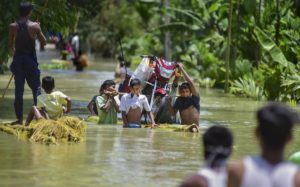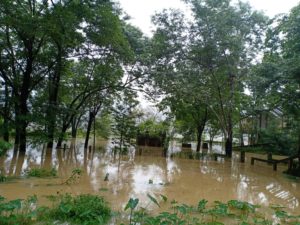Floods overwhelm pandemic-hit Assam
Assam’s annual ritual of devastating floods comes on the back of a sharp spike in the number of coronavirus cases. Now a cocktail of the two dangers threatens not just millions of humans but also puts in peril the state’s rich wildlife.
“There aren’t enough relief camps and other safe places for us to stay. We barely managed to save our lives from the flood, so how could we save our cows and buffaloes? Who will bring my crops back or make my farm cultivable again?” asks Kaushik Das, 32, a resident of Sonapur, about 35 km away from the state capital Dispur in Assam.
Caught between the mighty Brahmaputra and Umtru Digharu, a small local river, Das is one amongst the millions in Assam who have been caught in the spate of floods, that unfortunately have become an annual ritual for people in many states across India.
This year, too, the Monsoons have been unforgiving in this part of the country. Das and nearly five million other Assamese have lost their standing crops as well as cattle and many have also seen their homes swept away or at least heavily damaged in the fury of the river. To escape the floodwaters and save themselves, many people migrate to higher grounds in the region where they stay, but every so often they are unable to cart away anything besides the most precious possessions, leaving the rest at the mercy of the waters.
Dimpi Barua, a house help, living in the same region as Das, says the Assam floods have forced people living in the low lying areas hit by the floods to flee to places at a higher elevation, which is also where relief camps have been set up by the state government for the flood-affected people. However, with millions of people seeking shelter, the relief camps and their surroundings, too, have become crowded. As a result, people are living in tents in the camps, or set up their own temporary huts on empty grounds and some are even sleeping under trees beside the roads. While the authorities say they have set up enough relief camps to accommodate all the flood-affected persons, many are yet to receive any assistance from the government or any social organisation.
The sudden crowding of the areas has the spectre of raised another serious threat to the locals there. With very limited space and too many people, the notion of social distancing, which is necessary to keep the threat of Covid-19 at bay, is more of a luxury at best or simply a fiction at worst. Indeed, Assam has registered a flare-up in the number of infections over the past fortnight. The number of positive cases in the state has almost doubled from 14,600 on July 9 to about 28,000 on July 22.
“I feel the pandemic and the flood will kill people like never before. There seems absolutely no way that one’s life can be saved from both,” Manik Lalthanlian, a resident of Kamrup, about 40 km north of Dispur, tells Media India Group. Lalthanlian is one of the few Assamese who has been spared by the floods and the pandemic. In order to help the less fortunate ones, he has been visiting relief camps in his area to donate food to the flood-affected. He says that he does not see much hope for a quick recovery in the fortunes of the people living in the relief camps.
Even though the floods have so far claimed ninety lives, the floods have killed many more animals. Assam is one of the richest wildlife states of India, with numerous sanctuaries dotting the state. They are home to the Indian one-horned rhino, elephants, tigers, several other carnivores as well as a wide variety of deer and birds. Each year, the floods claim lives of thousands of these animals, including dozens of the endangered species like the rhinos and tigers.
The Kaziranga National Park, one of the largest and most famous sanctuaries in Assam, has been hit particularly hard and various animals have tried to escape the rising waters by moving towards the nearby villages as well as the main roads in search of highlands. However, the floods have already claimed around 225 animals, including 15 of its prized rhinos, four elephants, a tiger as well as 180 hog deer, according to the data of Federation of Indian Animals Protection Organisation.
The rush of animals towards villages has led to several incidents of human-animal conflict, especially poaching as gangs of poachers become very active at a time when the state administration and the park rangers are busy providing safe higher grounds to the flood-affected animals.
However, on a larger scale, most residents of Assam are used to being in the vicinity of the wildlife. Villages like Kanhulimari and Nagaon, just outside the Kaziranga, have become a common habitat for the wild animals these days. Though these animals don’t harm humans very often, they prey on house pets when hungry.
Even when the waters recede, the troubles for the flood-affected people won’t end as rebuilding their homes and lives can take a good part of a year, almost in time for the next wave of floods. “There is no possibility of agriculture for about six or seven months now. My land is filled with water. The crops are ruined and the soil is ruined. I will have to work as a labourer on someone else’s land,’’ says Anigoi Das, also from Sonapur. Das is a full-time stage actor or Dhulia, who usually earns his livelihood by performing shows in various nearby villages. However, the coronavirus pandemic and the ensuing lockdown has put paid to his acting career for over four months now. ‘‘Shows had stopped about four months ago. I don’t think stage shows will be allowed anytime soon. When I was doing shows, I earned about INR 10,000 per month. My sister also acted in stage shows and earned the same amount. Our parents worked on our small land and we earned by selling crops too. Since the lockdown, however, we had been living off our savings and before the floods, we were really hoping for the shows to start as the lockdown was being eased gradually,” says Das.
While the state’s residents continue to deal stoically with the floods that seem to be intrinsically linked to their fate, a few do wonder if the government would ever bother to find a solution to at least lessen their pain.
“People say we’re lucky to have come on the upper regions and this is, after all, a yearly occurrence in here. If this happens every year, why don’t the authorities or the government do something to prepare? Within one or two days only, everything we owned is washed away!” says Dimpi Barua, 30, who is currently seeking shelter at one of the relief camps in Sonapur.











